Legal System for Business: Classifications of Law, Source of Law, and UK Law Making Process for Employment Law
VerifiedAdded on 2023/06/13
|8
|2765
|295
AI Summary
This report discusses the legal system for business in the UK, covering classifications of law, source of law, and the UK law making process for employment law. It also explains the role of courts in the English legal system and the statutory duties of employers to their employees.
Contribute Materials
Your contribution can guide someone’s learning journey. Share your
documents today.
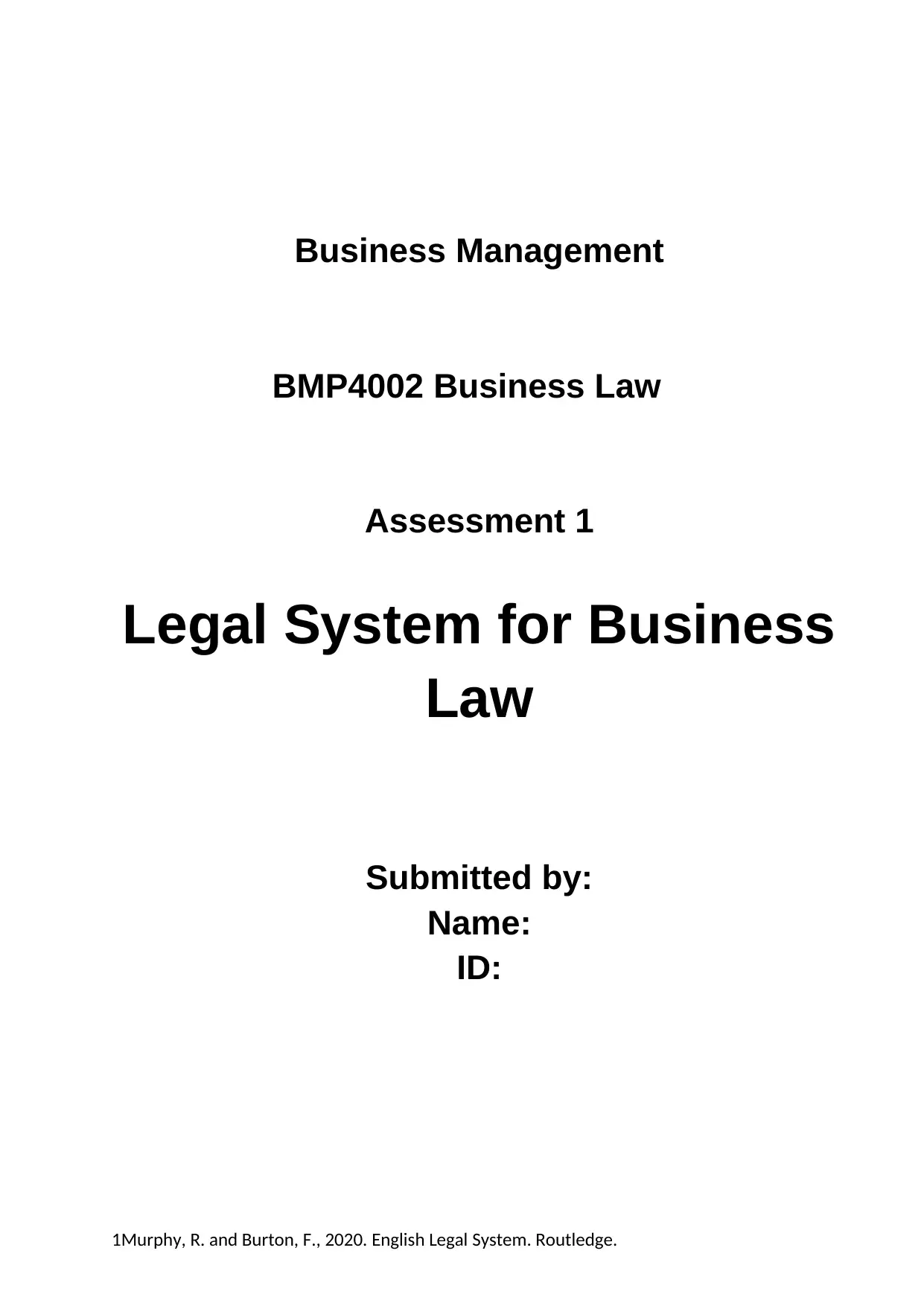
Business Management
BMP4002 Business Law
Assessment 1
Legal System for Business
Law
Submitted by:
Name:
ID:
1Murphy, R. and Burton, F., 2020. English Legal System. Routledge.
BMP4002 Business Law
Assessment 1
Legal System for Business
Law
Submitted by:
Name:
ID:
1Murphy, R. and Burton, F., 2020. English Legal System. Routledge.
Secure Best Marks with AI Grader
Need help grading? Try our AI Grader for instant feedback on your assignments.
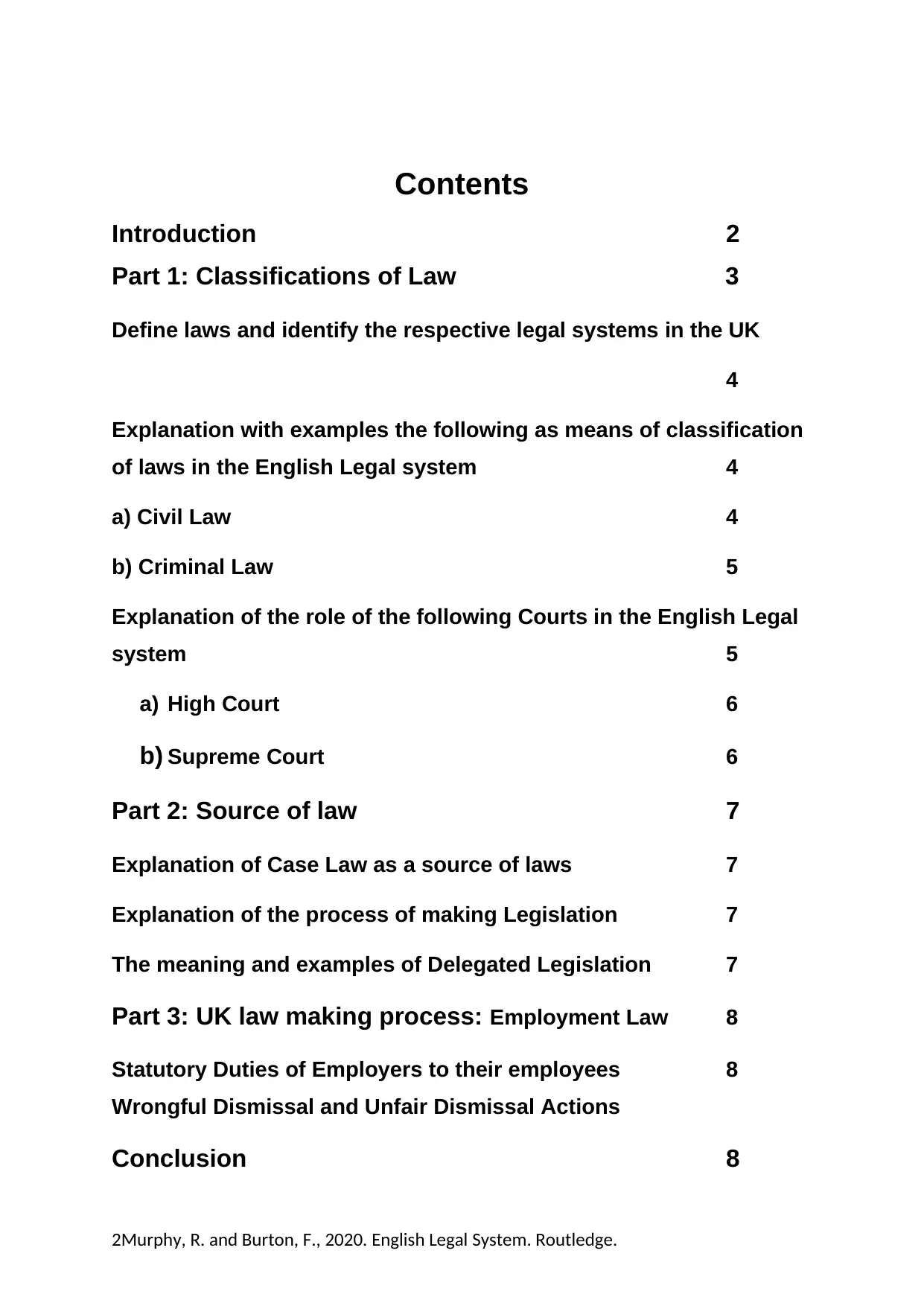
Contents
Introduction 2
Part 1: Classifications of Law 3
Define laws and identify the respective legal systems in the UK
4
Explanation with examples the following as means of classification
of laws in the English Legal system 4
a) Civil Law 4
b) Criminal Law 5
Explanation of the role of the following Courts in the English Legal
system 5
a) High Court 6
b) Supreme Court 6
Part 2: Source of law 7
Explanation of Case Law as a source of laws 7
Explanation of the process of making Legislation 7
The meaning and examples of Delegated Legislation 7
Part 3: UK law making process: Employment Law 8
Statutory Duties of Employers to their employees 8
Wrongful Dismissal and Unfair Dismissal Actions
Conclusion 8
2Murphy, R. and Burton, F., 2020. English Legal System. Routledge.
Introduction 2
Part 1: Classifications of Law 3
Define laws and identify the respective legal systems in the UK
4
Explanation with examples the following as means of classification
of laws in the English Legal system 4
a) Civil Law 4
b) Criminal Law 5
Explanation of the role of the following Courts in the English Legal
system 5
a) High Court 6
b) Supreme Court 6
Part 2: Source of law 7
Explanation of Case Law as a source of laws 7
Explanation of the process of making Legislation 7
The meaning and examples of Delegated Legislation 7
Part 3: UK law making process: Employment Law 8
Statutory Duties of Employers to their employees 8
Wrongful Dismissal and Unfair Dismissal Actions
Conclusion 8
2Murphy, R. and Burton, F., 2020. English Legal System. Routledge.
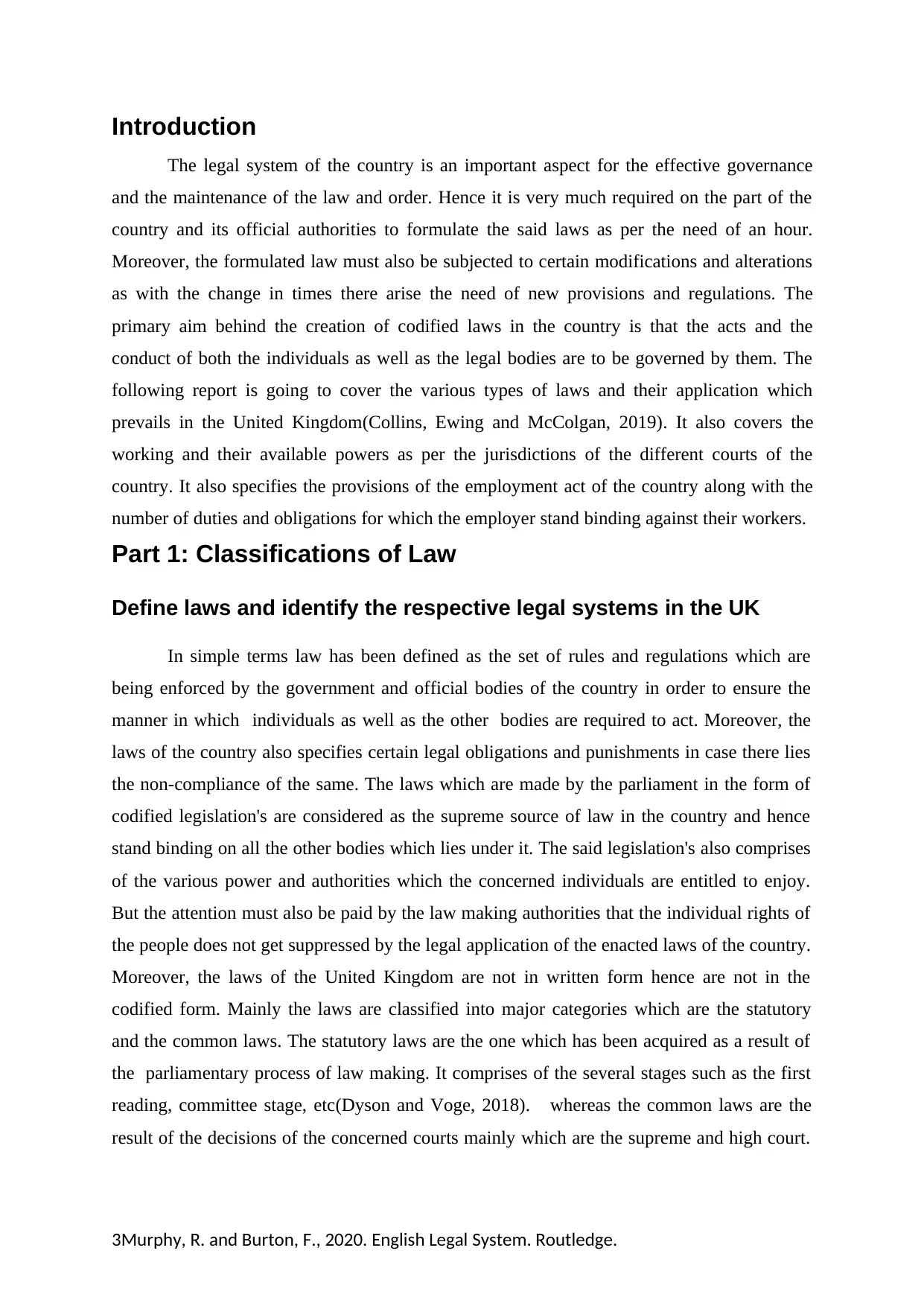
Introduction
The legal system of the country is an important aspect for the effective governance
and the maintenance of the law and order. Hence it is very much required on the part of the
country and its official authorities to formulate the said laws as per the need of an hour.
Moreover, the formulated law must also be subjected to certain modifications and alterations
as with the change in times there arise the need of new provisions and regulations. The
primary aim behind the creation of codified laws in the country is that the acts and the
conduct of both the individuals as well as the legal bodies are to be governed by them. The
following report is going to cover the various types of laws and their application which
prevails in the United Kingdom(Collins, Ewing and McColgan, 2019). It also covers the
working and their available powers as per the jurisdictions of the different courts of the
country. It also specifies the provisions of the employment act of the country along with the
number of duties and obligations for which the employer stand binding against their workers.
Part 1: Classifications of Law
Define laws and identify the respective legal systems in the UK
In simple terms law has been defined as the set of rules and regulations which are
being enforced by the government and official bodies of the country in order to ensure the
manner in which individuals as well as the other bodies are required to act. Moreover, the
laws of the country also specifies certain legal obligations and punishments in case there lies
the non-compliance of the same. The laws which are made by the parliament in the form of
codified legislation's are considered as the supreme source of law in the country and hence
stand binding on all the other bodies which lies under it. The said legislation's also comprises
of the various power and authorities which the concerned individuals are entitled to enjoy.
But the attention must also be paid by the law making authorities that the individual rights of
the people does not get suppressed by the legal application of the enacted laws of the country.
Moreover, the laws of the United Kingdom are not in written form hence are not in the
codified form. Mainly the laws are classified into major categories which are the statutory
and the common laws. The statutory laws are the one which has been acquired as a result of
the parliamentary process of law making. It comprises of the several stages such as the first
reading, committee stage, etc(Dyson and Voge, 2018). whereas the common laws are the
result of the decisions of the concerned courts mainly which are the supreme and high court.
3Murphy, R. and Burton, F., 2020. English Legal System. Routledge.
The legal system of the country is an important aspect for the effective governance
and the maintenance of the law and order. Hence it is very much required on the part of the
country and its official authorities to formulate the said laws as per the need of an hour.
Moreover, the formulated law must also be subjected to certain modifications and alterations
as with the change in times there arise the need of new provisions and regulations. The
primary aim behind the creation of codified laws in the country is that the acts and the
conduct of both the individuals as well as the legal bodies are to be governed by them. The
following report is going to cover the various types of laws and their application which
prevails in the United Kingdom(Collins, Ewing and McColgan, 2019). It also covers the
working and their available powers as per the jurisdictions of the different courts of the
country. It also specifies the provisions of the employment act of the country along with the
number of duties and obligations for which the employer stand binding against their workers.
Part 1: Classifications of Law
Define laws and identify the respective legal systems in the UK
In simple terms law has been defined as the set of rules and regulations which are
being enforced by the government and official bodies of the country in order to ensure the
manner in which individuals as well as the other bodies are required to act. Moreover, the
laws of the country also specifies certain legal obligations and punishments in case there lies
the non-compliance of the same. The laws which are made by the parliament in the form of
codified legislation's are considered as the supreme source of law in the country and hence
stand binding on all the other bodies which lies under it. The said legislation's also comprises
of the various power and authorities which the concerned individuals are entitled to enjoy.
But the attention must also be paid by the law making authorities that the individual rights of
the people does not get suppressed by the legal application of the enacted laws of the country.
Moreover, the laws of the United Kingdom are not in written form hence are not in the
codified form. Mainly the laws are classified into major categories which are the statutory
and the common laws. The statutory laws are the one which has been acquired as a result of
the parliamentary process of law making. It comprises of the several stages such as the first
reading, committee stage, etc(Dyson and Voge, 2018). whereas the common laws are the
result of the decisions of the concerned courts mainly which are the supreme and high court.
3Murphy, R. and Burton, F., 2020. English Legal System. Routledge.
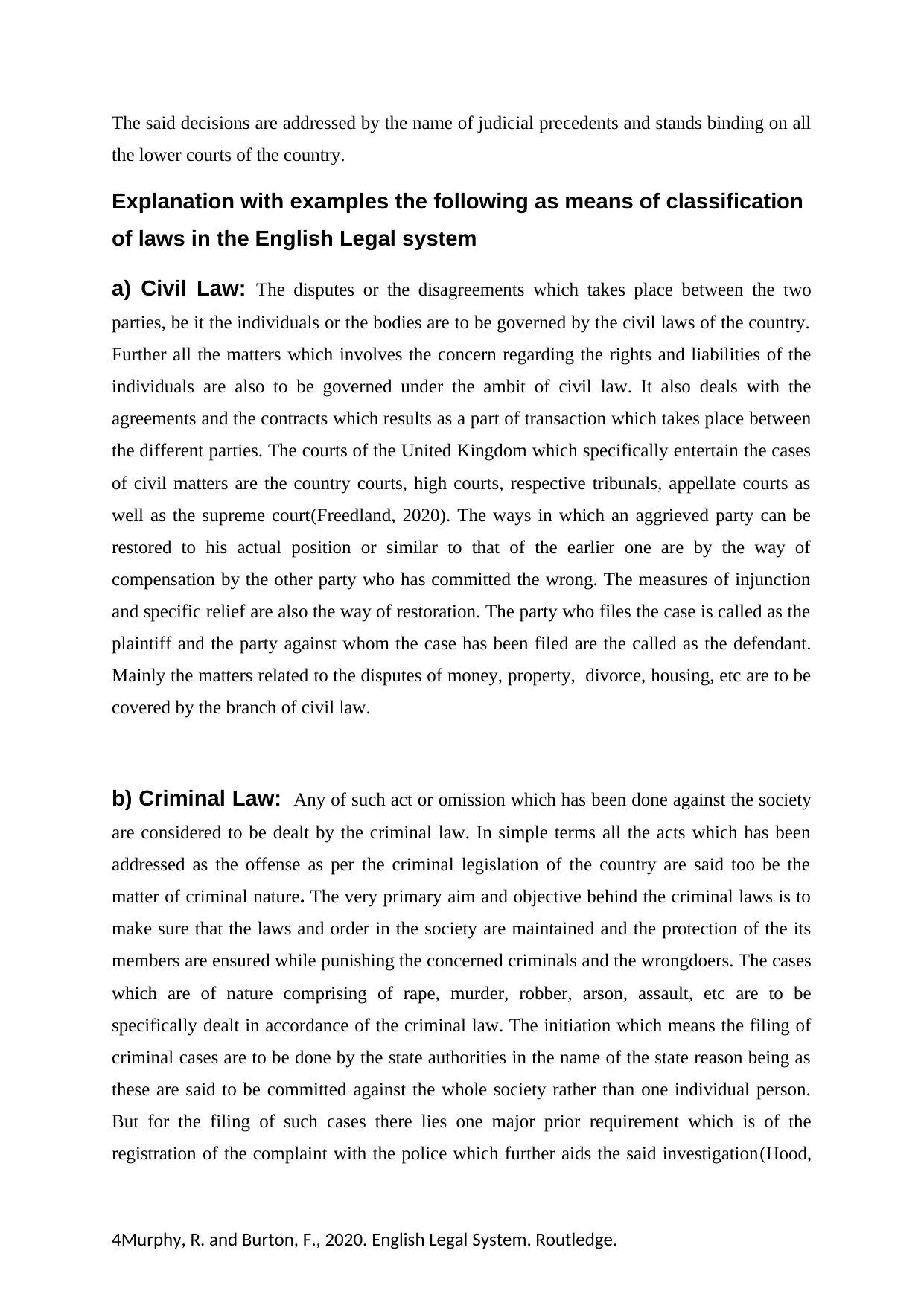
The said decisions are addressed by the name of judicial precedents and stands binding on all
the lower courts of the country.
Explanation with examples the following as means of classification
of laws in the English Legal system
a) Civil Law: The disputes or the disagreements which takes place between the two
parties, be it the individuals or the bodies are to be governed by the civil laws of the country.
Further all the matters which involves the concern regarding the rights and liabilities of the
individuals are also to be governed under the ambit of civil law. It also deals with the
agreements and the contracts which results as a part of transaction which takes place between
the different parties. The courts of the United Kingdom which specifically entertain the cases
of civil matters are the country courts, high courts, respective tribunals, appellate courts as
well as the supreme court(Freedland, 2020). The ways in which an aggrieved party can be
restored to his actual position or similar to that of the earlier one are by the way of
compensation by the other party who has committed the wrong. The measures of injunction
and specific relief are also the way of restoration. The party who files the case is called as the
plaintiff and the party against whom the case has been filed are the called as the defendant.
Mainly the matters related to the disputes of money, property, divorce, housing, etc are to be
covered by the branch of civil law.
b) Criminal Law: Any of such act or omission which has been done against the society
are considered to be dealt by the criminal law. In simple terms all the acts which has been
addressed as the offense as per the criminal legislation of the country are said too be the
matter of criminal nature. The very primary aim and objective behind the criminal laws is to
make sure that the laws and order in the society are maintained and the protection of the its
members are ensured while punishing the concerned criminals and the wrongdoers. The cases
which are of nature comprising of rape, murder, robber, arson, assault, etc are to be
specifically dealt in accordance of the criminal law. The initiation which means the filing of
criminal cases are to be done by the state authorities in the name of the state reason being as
these are said to be committed against the whole society rather than one individual person.
But for the filing of such cases there lies one major prior requirement which is of the
registration of the complaint with the police which further aids the said investigation(Hood,
4Murphy, R. and Burton, F., 2020. English Legal System. Routledge.
the lower courts of the country.
Explanation with examples the following as means of classification
of laws in the English Legal system
a) Civil Law: The disputes or the disagreements which takes place between the two
parties, be it the individuals or the bodies are to be governed by the civil laws of the country.
Further all the matters which involves the concern regarding the rights and liabilities of the
individuals are also to be governed under the ambit of civil law. It also deals with the
agreements and the contracts which results as a part of transaction which takes place between
the different parties. The courts of the United Kingdom which specifically entertain the cases
of civil matters are the country courts, high courts, respective tribunals, appellate courts as
well as the supreme court(Freedland, 2020). The ways in which an aggrieved party can be
restored to his actual position or similar to that of the earlier one are by the way of
compensation by the other party who has committed the wrong. The measures of injunction
and specific relief are also the way of restoration. The party who files the case is called as the
plaintiff and the party against whom the case has been filed are the called as the defendant.
Mainly the matters related to the disputes of money, property, divorce, housing, etc are to be
covered by the branch of civil law.
b) Criminal Law: Any of such act or omission which has been done against the society
are considered to be dealt by the criminal law. In simple terms all the acts which has been
addressed as the offense as per the criminal legislation of the country are said too be the
matter of criminal nature. The very primary aim and objective behind the criminal laws is to
make sure that the laws and order in the society are maintained and the protection of the its
members are ensured while punishing the concerned criminals and the wrongdoers. The cases
which are of nature comprising of rape, murder, robber, arson, assault, etc are to be
specifically dealt in accordance of the criminal law. The initiation which means the filing of
criminal cases are to be done by the state authorities in the name of the state reason being as
these are said to be committed against the whole society rather than one individual person.
But for the filing of such cases there lies one major prior requirement which is of the
registration of the complaint with the police which further aids the said investigation(Hood,
4Murphy, R. and Burton, F., 2020. English Legal System. Routledge.
Secure Best Marks with AI Grader
Need help grading? Try our AI Grader for instant feedback on your assignments.
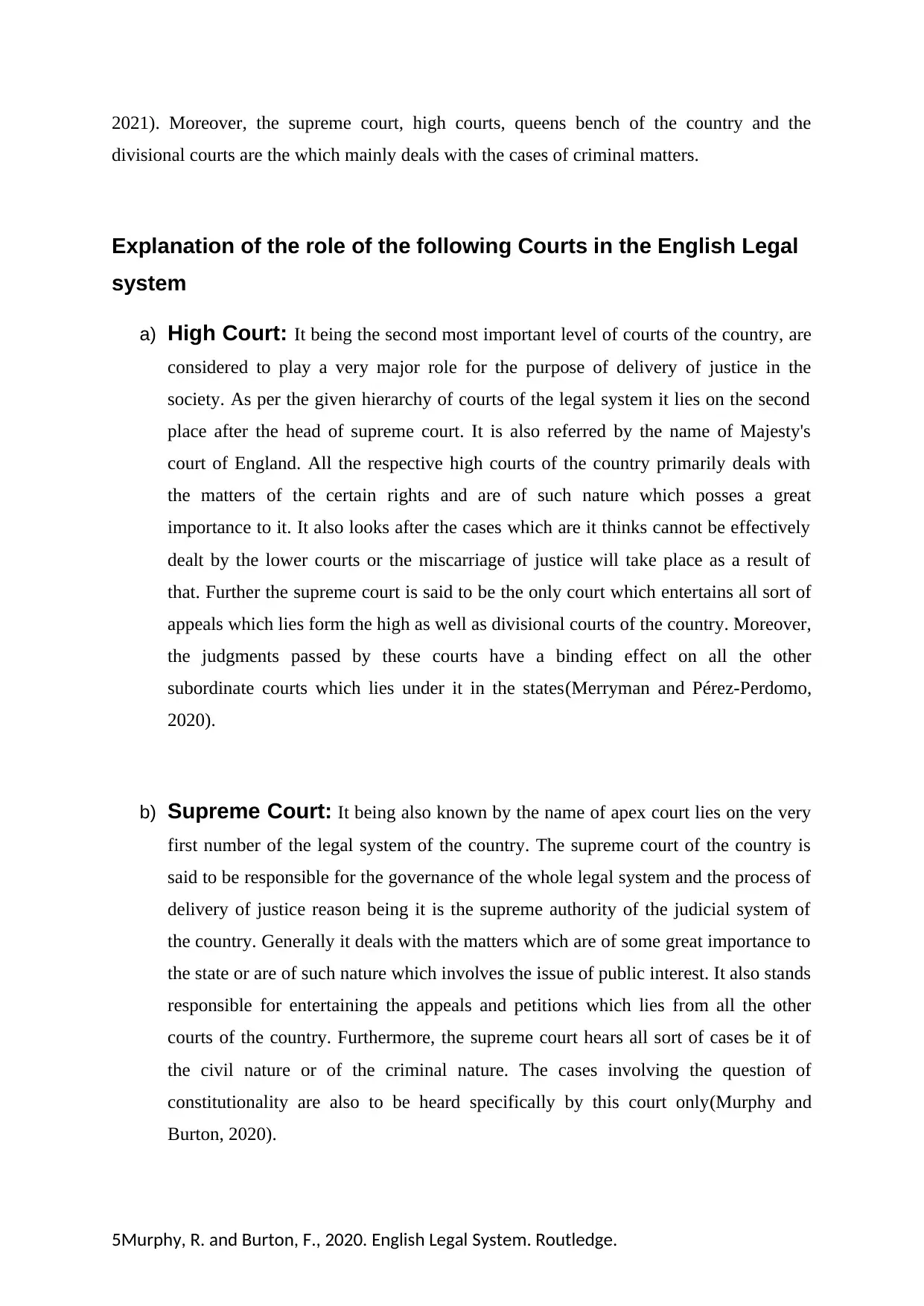
2021). Moreover, the supreme court, high courts, queens bench of the country and the
divisional courts are the which mainly deals with the cases of criminal matters.
Explanation of the role of the following Courts in the English Legal
system
a) High Court: It being the second most important level of courts of the country, are
considered to play a very major role for the purpose of delivery of justice in the
society. As per the given hierarchy of courts of the legal system it lies on the second
place after the head of supreme court. It is also referred by the name of Majesty's
court of England. All the respective high courts of the country primarily deals with
the matters of the certain rights and are of such nature which posses a great
importance to it. It also looks after the cases which are it thinks cannot be effectively
dealt by the lower courts or the miscarriage of justice will take place as a result of
that. Further the supreme court is said to be the only court which entertains all sort of
appeals which lies form the high as well as divisional courts of the country. Moreover,
the judgments passed by these courts have a binding effect on all the other
subordinate courts which lies under it in the states(Merryman and Pérez-Perdomo,
2020).
b) Supreme Court: It being also known by the name of apex court lies on the very
first number of the legal system of the country. The supreme court of the country is
said to be responsible for the governance of the whole legal system and the process of
delivery of justice reason being it is the supreme authority of the judicial system of
the country. Generally it deals with the matters which are of some great importance to
the state or are of such nature which involves the issue of public interest. It also stands
responsible for entertaining the appeals and petitions which lies from all the other
courts of the country. Furthermore, the supreme court hears all sort of cases be it of
the civil nature or of the criminal nature. The cases involving the question of
constitutionality are also to be heard specifically by this court only(Murphy and
Burton, 2020).
5Murphy, R. and Burton, F., 2020. English Legal System. Routledge.
divisional courts are the which mainly deals with the cases of criminal matters.
Explanation of the role of the following Courts in the English Legal
system
a) High Court: It being the second most important level of courts of the country, are
considered to play a very major role for the purpose of delivery of justice in the
society. As per the given hierarchy of courts of the legal system it lies on the second
place after the head of supreme court. It is also referred by the name of Majesty's
court of England. All the respective high courts of the country primarily deals with
the matters of the certain rights and are of such nature which posses a great
importance to it. It also looks after the cases which are it thinks cannot be effectively
dealt by the lower courts or the miscarriage of justice will take place as a result of
that. Further the supreme court is said to be the only court which entertains all sort of
appeals which lies form the high as well as divisional courts of the country. Moreover,
the judgments passed by these courts have a binding effect on all the other
subordinate courts which lies under it in the states(Merryman and Pérez-Perdomo,
2020).
b) Supreme Court: It being also known by the name of apex court lies on the very
first number of the legal system of the country. The supreme court of the country is
said to be responsible for the governance of the whole legal system and the process of
delivery of justice reason being it is the supreme authority of the judicial system of
the country. Generally it deals with the matters which are of some great importance to
the state or are of such nature which involves the issue of public interest. It also stands
responsible for entertaining the appeals and petitions which lies from all the other
courts of the country. Furthermore, the supreme court hears all sort of cases be it of
the civil nature or of the criminal nature. The cases involving the question of
constitutionality are also to be heard specifically by this court only(Murphy and
Burton, 2020).
5Murphy, R. and Burton, F., 2020. English Legal System. Routledge.
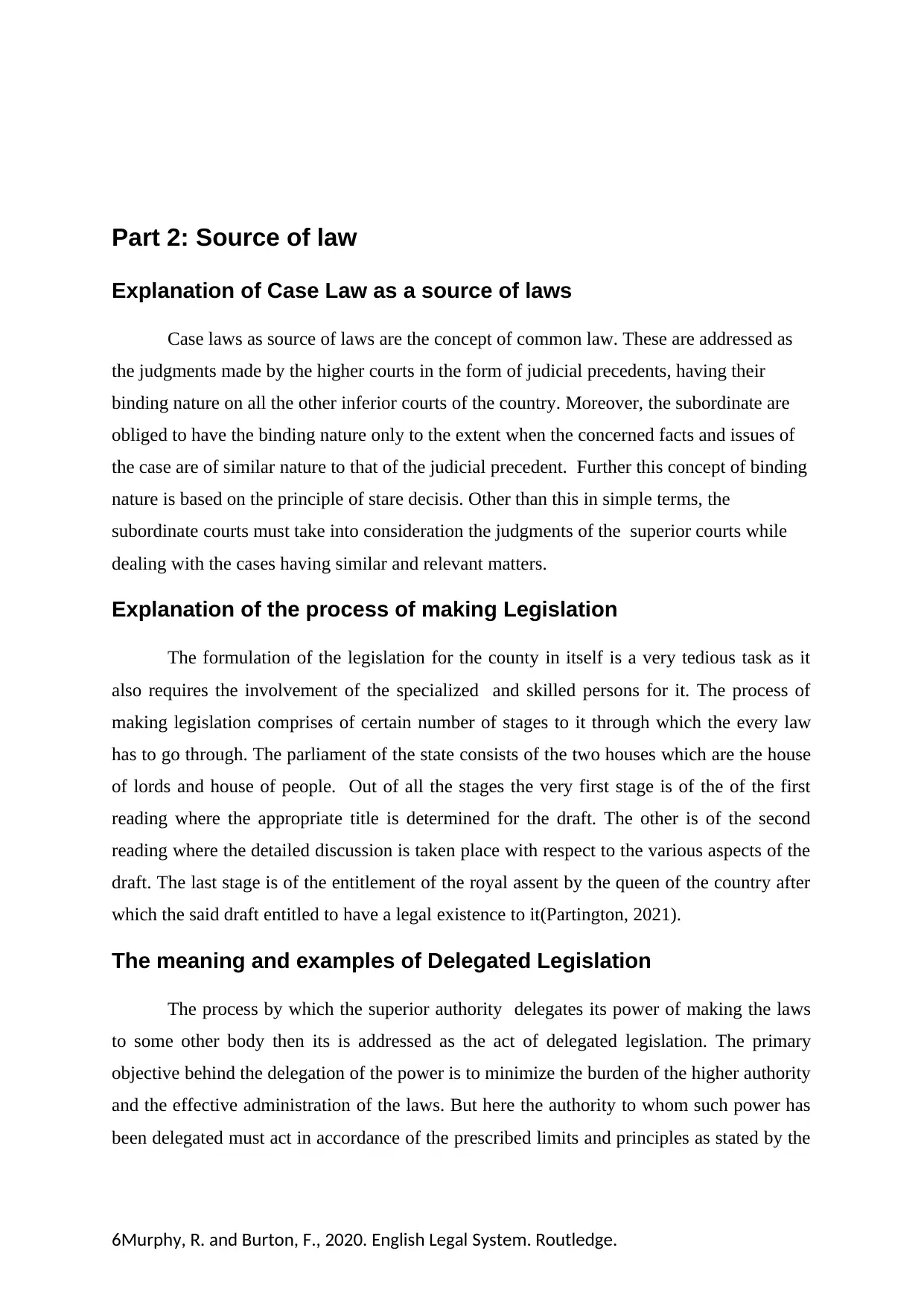
Part 2: Source of law
Explanation of Case Law as a source of laws
Case laws as source of laws are the concept of common law. These are addressed as
the judgments made by the higher courts in the form of judicial precedents, having their
binding nature on all the other inferior courts of the country. Moreover, the subordinate are
obliged to have the binding nature only to the extent when the concerned facts and issues of
the case are of similar nature to that of the judicial precedent. Further this concept of binding
nature is based on the principle of stare decisis. Other than this in simple terms, the
subordinate courts must take into consideration the judgments of the superior courts while
dealing with the cases having similar and relevant matters.
Explanation of the process of making Legislation
The formulation of the legislation for the county in itself is a very tedious task as it
also requires the involvement of the specialized and skilled persons for it. The process of
making legislation comprises of certain number of stages to it through which the every law
has to go through. The parliament of the state consists of the two houses which are the house
of lords and house of people. Out of all the stages the very first stage is of the of the first
reading where the appropriate title is determined for the draft. The other is of the second
reading where the detailed discussion is taken place with respect to the various aspects of the
draft. The last stage is of the entitlement of the royal assent by the queen of the country after
which the said draft entitled to have a legal existence to it(Partington, 2021).
The meaning and examples of Delegated Legislation
The process by which the superior authority delegates its power of making the laws
to some other body then its is addressed as the act of delegated legislation. The primary
objective behind the delegation of the power is to minimize the burden of the higher authority
and the effective administration of the laws. But here the authority to whom such power has
been delegated must act in accordance of the prescribed limits and principles as stated by the
6Murphy, R. and Burton, F., 2020. English Legal System. Routledge.
Explanation of Case Law as a source of laws
Case laws as source of laws are the concept of common law. These are addressed as
the judgments made by the higher courts in the form of judicial precedents, having their
binding nature on all the other inferior courts of the country. Moreover, the subordinate are
obliged to have the binding nature only to the extent when the concerned facts and issues of
the case are of similar nature to that of the judicial precedent. Further this concept of binding
nature is based on the principle of stare decisis. Other than this in simple terms, the
subordinate courts must take into consideration the judgments of the superior courts while
dealing with the cases having similar and relevant matters.
Explanation of the process of making Legislation
The formulation of the legislation for the county in itself is a very tedious task as it
also requires the involvement of the specialized and skilled persons for it. The process of
making legislation comprises of certain number of stages to it through which the every law
has to go through. The parliament of the state consists of the two houses which are the house
of lords and house of people. Out of all the stages the very first stage is of the of the first
reading where the appropriate title is determined for the draft. The other is of the second
reading where the detailed discussion is taken place with respect to the various aspects of the
draft. The last stage is of the entitlement of the royal assent by the queen of the country after
which the said draft entitled to have a legal existence to it(Partington, 2021).
The meaning and examples of Delegated Legislation
The process by which the superior authority delegates its power of making the laws
to some other body then its is addressed as the act of delegated legislation. The primary
objective behind the delegation of the power is to minimize the burden of the higher authority
and the effective administration of the laws. But here the authority to whom such power has
been delegated must act in accordance of the prescribed limits and principles as stated by the
6Murphy, R. and Burton, F., 2020. English Legal System. Routledge.
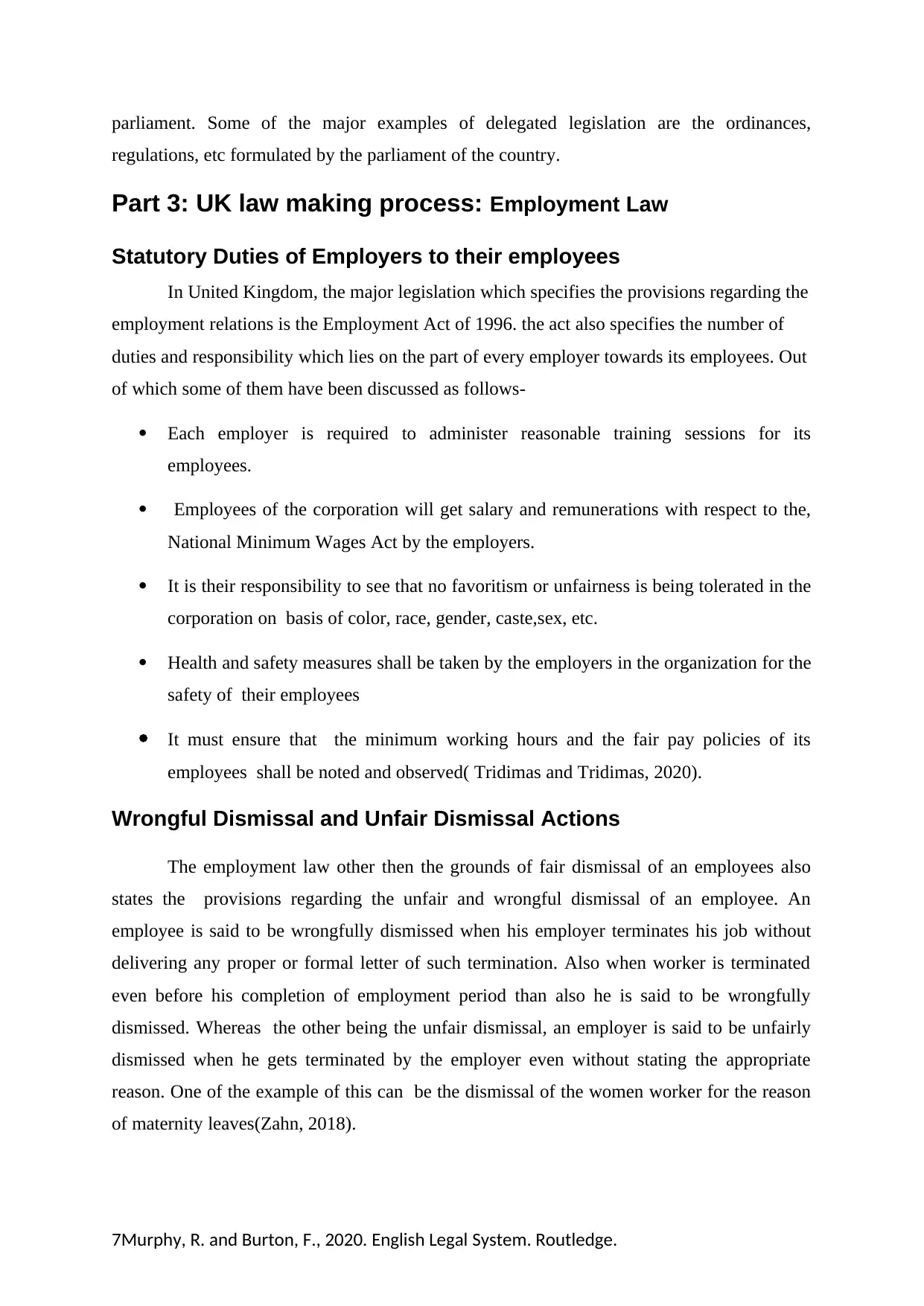
parliament. Some of the major examples of delegated legislation are the ordinances,
regulations, etc formulated by the parliament of the country.
Part 3: UK law making process: Employment Law
Statutory Duties of Employers to their employees
In United Kingdom, the major legislation which specifies the provisions regarding the
employment relations is the Employment Act of 1996. the act also specifies the number of
duties and responsibility which lies on the part of every employer towards its employees. Out
of which some of them have been discussed as follows-
Each employer is required to administer reasonable training sessions for its
employees.
Employees of the corporation will get salary and remunerations with respect to the,
National Minimum Wages Act by the employers.
It is their responsibility to see that no favoritism or unfairness is being tolerated in the
corporation on basis of color, race, gender, caste,sex, etc.
Health and safety measures shall be taken by the employers in the organization for the
safety of their employees
It must ensure that the minimum working hours and the fair pay policies of its
employees shall be noted and observed( Tridimas and Tridimas, 2020).
Wrongful Dismissal and Unfair Dismissal Actions
The employment law other then the grounds of fair dismissal of an employees also
states the provisions regarding the unfair and wrongful dismissal of an employee. An
employee is said to be wrongfully dismissed when his employer terminates his job without
delivering any proper or formal letter of such termination. Also when worker is terminated
even before his completion of employment period than also he is said to be wrongfully
dismissed. Whereas the other being the unfair dismissal, an employer is said to be unfairly
dismissed when he gets terminated by the employer even without stating the appropriate
reason. One of the example of this can be the dismissal of the women worker for the reason
of maternity leaves(Zahn, 2018).
7Murphy, R. and Burton, F., 2020. English Legal System. Routledge.
regulations, etc formulated by the parliament of the country.
Part 3: UK law making process: Employment Law
Statutory Duties of Employers to their employees
In United Kingdom, the major legislation which specifies the provisions regarding the
employment relations is the Employment Act of 1996. the act also specifies the number of
duties and responsibility which lies on the part of every employer towards its employees. Out
of which some of them have been discussed as follows-
Each employer is required to administer reasonable training sessions for its
employees.
Employees of the corporation will get salary and remunerations with respect to the,
National Minimum Wages Act by the employers.
It is their responsibility to see that no favoritism or unfairness is being tolerated in the
corporation on basis of color, race, gender, caste,sex, etc.
Health and safety measures shall be taken by the employers in the organization for the
safety of their employees
It must ensure that the minimum working hours and the fair pay policies of its
employees shall be noted and observed( Tridimas and Tridimas, 2020).
Wrongful Dismissal and Unfair Dismissal Actions
The employment law other then the grounds of fair dismissal of an employees also
states the provisions regarding the unfair and wrongful dismissal of an employee. An
employee is said to be wrongfully dismissed when his employer terminates his job without
delivering any proper or formal letter of such termination. Also when worker is terminated
even before his completion of employment period than also he is said to be wrongfully
dismissed. Whereas the other being the unfair dismissal, an employer is said to be unfairly
dismissed when he gets terminated by the employer even without stating the appropriate
reason. One of the example of this can be the dismissal of the women worker for the reason
of maternity leaves(Zahn, 2018).
7Murphy, R. and Burton, F., 2020. English Legal System. Routledge.
Paraphrase This Document
Need a fresh take? Get an instant paraphrase of this document with our AI Paraphraser
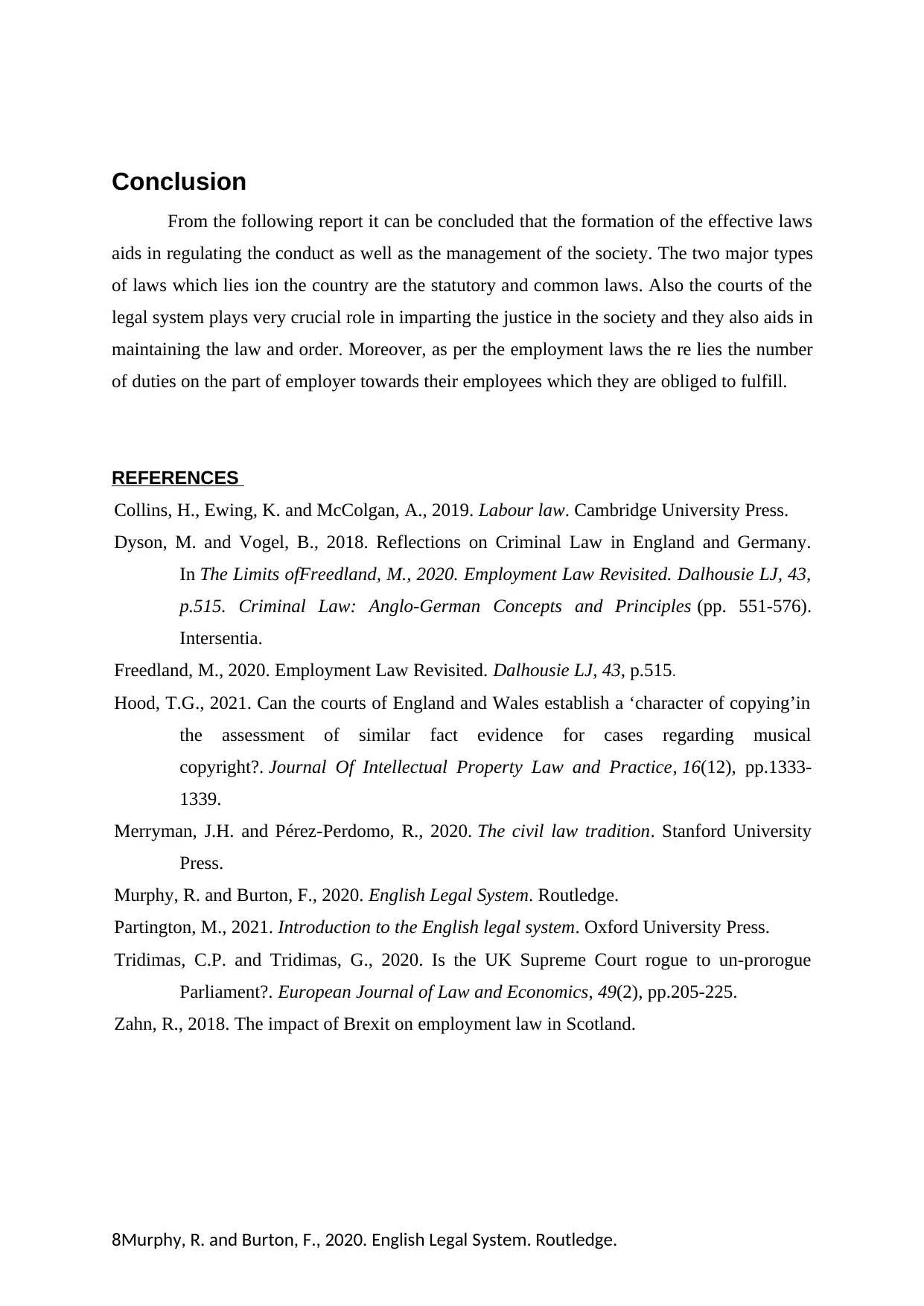
Conclusion
From the following report it can be concluded that the formation of the effective laws
aids in regulating the conduct as well as the management of the society. The two major types
of laws which lies ion the country are the statutory and common laws. Also the courts of the
legal system plays very crucial role in imparting the justice in the society and they also aids in
maintaining the law and order. Moreover, as per the employment laws the re lies the number
of duties on the part of employer towards their employees which they are obliged to fulfill.
REFERENCES
Collins, H., Ewing, K. and McColgan, A., 2019. Labour law. Cambridge University Press.
Dyson, M. and Vogel, B., 2018. Reflections on Criminal Law in England and Germany.
In The Limits ofFreedland, M., 2020. Employment Law Revisited. Dalhousie LJ, 43,
p.515. Criminal Law: Anglo-German Concepts and Principles (pp. 551-576).
Intersentia.
Freedland, M., 2020. Employment Law Revisited. Dalhousie LJ, 43, p.515.
Hood, T.G., 2021. Can the courts of England and Wales establish a ‘character of copying’in
the assessment of similar fact evidence for cases regarding musical
copyright?. Journal Of Intellectual Property Law and Practice, 16(12), pp.1333-
1339.
Merryman, J.H. and Pérez-Perdomo, R., 2020. The civil law tradition. Stanford University
Press.
Murphy, R. and Burton, F., 2020. English Legal System. Routledge.
Partington, M., 2021. Introduction to the English legal system. Oxford University Press.
Tridimas, C.P. and Tridimas, G., 2020. Is the UK Supreme Court rogue to un-prorogue
Parliament?. European Journal of Law and Economics, 49(2), pp.205-225.
Zahn, R., 2018. The impact of Brexit on employment law in Scotland.
8Murphy, R. and Burton, F., 2020. English Legal System. Routledge.
From the following report it can be concluded that the formation of the effective laws
aids in regulating the conduct as well as the management of the society. The two major types
of laws which lies ion the country are the statutory and common laws. Also the courts of the
legal system plays very crucial role in imparting the justice in the society and they also aids in
maintaining the law and order. Moreover, as per the employment laws the re lies the number
of duties on the part of employer towards their employees which they are obliged to fulfill.
REFERENCES
Collins, H., Ewing, K. and McColgan, A., 2019. Labour law. Cambridge University Press.
Dyson, M. and Vogel, B., 2018. Reflections on Criminal Law in England and Germany.
In The Limits ofFreedland, M., 2020. Employment Law Revisited. Dalhousie LJ, 43,
p.515. Criminal Law: Anglo-German Concepts and Principles (pp. 551-576).
Intersentia.
Freedland, M., 2020. Employment Law Revisited. Dalhousie LJ, 43, p.515.
Hood, T.G., 2021. Can the courts of England and Wales establish a ‘character of copying’in
the assessment of similar fact evidence for cases regarding musical
copyright?. Journal Of Intellectual Property Law and Practice, 16(12), pp.1333-
1339.
Merryman, J.H. and Pérez-Perdomo, R., 2020. The civil law tradition. Stanford University
Press.
Murphy, R. and Burton, F., 2020. English Legal System. Routledge.
Partington, M., 2021. Introduction to the English legal system. Oxford University Press.
Tridimas, C.P. and Tridimas, G., 2020. Is the UK Supreme Court rogue to un-prorogue
Parliament?. European Journal of Law and Economics, 49(2), pp.205-225.
Zahn, R., 2018. The impact of Brexit on employment law in Scotland.
8Murphy, R. and Burton, F., 2020. English Legal System. Routledge.
1 out of 8
Related Documents
Your All-in-One AI-Powered Toolkit for Academic Success.
+13062052269
info@desklib.com
Available 24*7 on WhatsApp / Email
![[object Object]](/_next/static/media/star-bottom.7253800d.svg)
Unlock your academic potential
© 2024 | Zucol Services PVT LTD | All rights reserved.